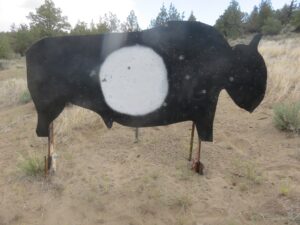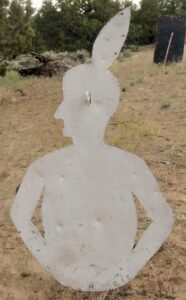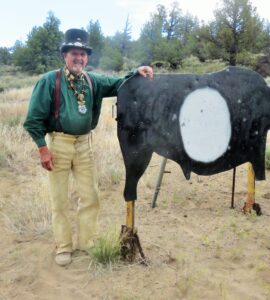THE GUN MAG
By Mike Nesbitt | Contributing Editor
(Editor’s Note: Billy Dixon was a buffalo hunter, frontier Army scout and plainsman credited with making an astounding rifle shot estimated at nearly one mile, killing a Native American warrior during the Second Battle of Adobe Walls in June 1874. That shot brought the three-day siege to an end. Three months later, in September 1874, Dixon, fellow scout Amos Chapman and four Cavalry soldiers were involved in what is called the Battle of Buffalo Wallow were awarded the Medal of Honor. Dixon is one of only eight civilians, including Chapman, ever to receive that award.)
The chance to do some 1200-yard shooting came my way and what an eye opening bit of fun that was.
Previously I had shot at both steel gongs and paper targets at 1000 yards with my Sharps rifles but going to 1200 yards was like playing a new ball game. And there was a good reason to do some 1200-yard shooting, I wanted to become a member of the Billy Dixon Society.
In honor and recognition of Billy Dixon’s long shot where he hit an attaching Comanche at a very long distance at the Battle of Adobe Walls, the Great Basin Sharps Shooters, near Bend, Oregon, have a special group within their club which they call the Billy Dixon Society. Being a member of the Billy Dixon Society requires qualification and joining that group isn’t particularly easy. I tried, just once so far, and I didn’t make it. I’ll tell you that right away but I’ll also say that I’ll try again, and if I need to, I’ll keep trying.
Here’s what a shooter must do in order to be included in the Great Basin’s Billy Dixon Society. Their range, part of the COSSA (Central Oregon Shooting Sports Association) shooting area, is generous enough that they have steel silhouette targets available out to 1,200 yards and a few more targets even further.
The Billy Dixon shots are taken at 1,200 yards and the shooter trying to become a Society member gets to take two sighter-shots at a full sized buffalo silhouette, and then gets three tries to hit a half-man sized (from the belt up) silhouette depicting a Native American warrior, shooting an iron sighted buffalo rifle from the sitting position while using cross-sticks. All it takes is one hit on the silhouette target and the shooter has bragging rights as well as being added to the list of Billy Dixon Society members. This is easier to explain than to accomplish because that’s a rather small target at just over 5/8ths of a mile.
At the previous 1,000-yard match I used my heaviest .44/77 Sharps rifle, “Hefty Hannah,” but because that rifle is equipped with a mid-range sight, another rifle had to be used. That other rifle is my “longest reaching” Sharps, an 1874 Hartford model by C. Sharps Arms with a #1 ½ Heavy barrel, 32 inches long, in .44/90 caliber shooting bullets weighting 470 grains. This was an easy choice because the .44/90 is equipped with a long-range rear sight.
The mid-range sight had enough elevation to reach 1,000 yards but not a whole lot farther. And, speaking about sight elevation adjustment, 1,200 yards is a lot farther than 1,000 yards, with my rifle needing another 46 “minutes” of sight elevation for that added 200 yards. Those 46 minutes elevate the rifle’s rear sight by almost another half-inch.
With my .44/90, I nestled down behind the cross-sticks to try getting a sight setting while Brownie Nash, one of the top men at the Great Basin Sharpshooters, set up his scope so he could “spot” my hits. I had used this rifle for targets at 1,000 yards before but not with the sight it is wearing now. So we had to “backup” to 800 yards, fire a couple of shots to check the sights at that closer distance, then “climb” to get settings for the farther targets.

When we finished I had sight settings for 800, 900, 1,000, 1,100, and 1,200 yards. And I was making good hits.
This, however, was just a sighting-in period and the hits would not be counted for score until the next day. During the sighting-in, I commented to Brownie how I wished the sun was shining brighter which would make the targets easier to see. Brownie replied that we’d shoot the long range targets right at first the next morning when the sun should shine very nicely on those distant targets.
I have another rifle that I could have used and maybe I’ll give that gun a good try when I go to the COSSA range again. That’s a Remington rolling block, re-built somewhat in the style of a Creedmoor model, in .44/77 caliber with a 32-inch barrel. It is equipped with a long range sight so it will definitely have the “reach” needed for 1200 yard shooting.
The .44/90, in my opinion, doesn’t have any great advantage with its slightly higher velocity over the .44/77 and for long range shooting both of those cartridges perform well with the same weight bullets. In fact, when the American and Irish teams were completing in long range competition at Creedmoor in the 1870s, where the Americans won by only 4 points in the match that was decided at 1,000 yards, some of the Americans used a particular .44/90 cartridge. But that cartridge used the 2 ¼” case of the .44/77.
It used a 90-grain powder charge under a paper patched bullet that was seated into the neck of the case very only a little way. And there was no lube between the powder and the bullet so the rifles had to be cleaned after every shot. That version of the .44/90, using the .44/77 brass, was called the .44/90 Regular and it was listed in the Winchester catalog until, at least, 1916.
Comparing my .44/77 rolling block with my .44/90 Sharps, I’d probably try using the Sharps again, mainly because the Sharps has a set trigger while the rolling block does not. At the same time, the rolling block has a good crisp trigger pull so it doesn’t have any great disadvantage. The actual decision on which to use will be pondered until the last minute before the shooting begins next time.
Back to the shooting at 1,200 yards, Mother Nature had her own agenda for that next morning. We must assume, certainly, that the sun was shining brightly but if so, that was well above the cloud cover that had blown in, being followed by a dandy storm. I had to take my chances and give it my best, no sunshine or whatever. Naturally, I began by taking my two sighter shots at the buffalo gong before trying to hit the smaller steel “Indian.” All I’d need would be one hit on the target to become a member of that prestigious group. With those darkened skies, I could only try.
My shooting wasn’t all bad but that’s the best thing I can say about it. The winds were rather calm that morning and as I sat behind the heavy .44/90 Sharps the white spot on the side of the black steel buffalo could be seen. The time of flight for the heavy bullet is at least three “long” seconds. Several shooters will spot their own shots by firing their rifle, then watching for the bullet’s impact through their spotting scopes. I relied on Brownie, Allen, or a couple of the other shooters to tell me where my bullets had gone. And to my delight, I made good hits with both shots on the buffalo, one of them almost in the middle of the big white spot.
Then came my three tries at the much smaller steel warrior silhouette and, although I was certainly trying my best, I didn’t hit it. I’d miss, then I’d hold the rifle tighter and squeeze the set trigger more slowly for the next shot, which was also a miss. All three shots missed.
The Great Basin Sharpshooters simply won’t give awards or recognition for close missing. I’ll just have to try again.
Trying to hit that small steel target at 1,200 yards is certainly a challenge and I really want to try that again.
If 1,200-yard shooting with a black powder “buffalo gun” interests you, got to the web site for the Great Basin Sharpshooters at https://greatbasinsharpshooters.com for more information. All you need is an iron sighted long range black powder rifle. One other nice thing to have is a little bit of luck.







